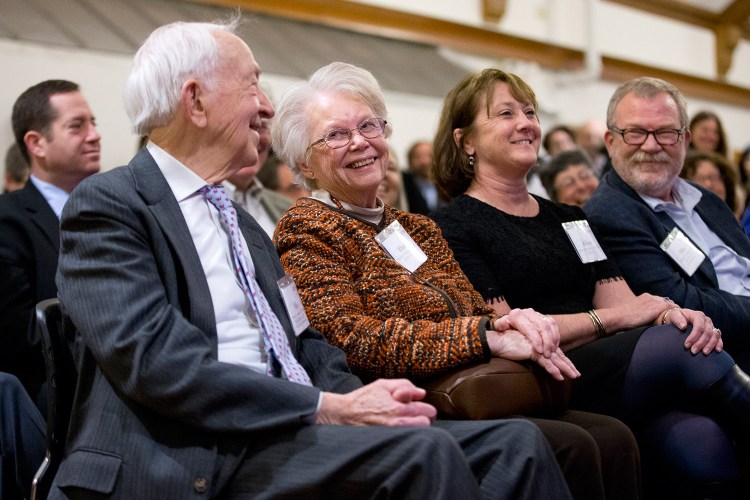Bates College in Lewiston will use its largest-ever single gift, $19 million, to create a new academic program that marries computer sciences with a more traditional liberal arts curriculum.
College President Clayton Spencer, in announcing the gift Monday, said the money will allow the school to add faculty members for the first time in more than a decade.
“This is a huge moment for Bates,” Spencer said. “Not only will we add three faculty members to support this new program, but we’ll add three more in areas of strong student interest and where we already have strong programs.”
The contribution was made by seven different families, with the largest share – $10 million – coming from 1980 graduate Michael Bonney, current chair of the board of trustees, and his wife, Alison Grott Bonney, also a 1980 graduate.
Michael Bonney said his family has strong ties to Bates – his grandfather and father both graduated, as did all three of his children – and wanted to support the college’s future.
“I’ve never been more optimistic about the future of Bates than I am at this moment,” said Bonney, who works as a venture capitalist in Boston and also built a career in biopharmaceuticals, first with Zeneca, which is now part of Astra-Zeneca, then with Biogen Inc., and finally with Cubist Pharmaceuticals, which he retired from in 2014 after 12 years as CEO.
In addition to the Bonneys’ gift, significant commitments have come from six other families with Bates alumni: George and Ann Colony of Concord, Massachusetts; Darrell Crate of Hamilton, Massachusetts; J. Blair Frank and Tena Fishman Frank of Pacific Palisades, California; and three anonymous families.
The $19 million gift will fund three new professorships within a new program in digital and computational studies beginning in fall 2017. It also will create three endowed professorships in neuroscience, economics, and chemistry with a preference for biological chemistry.
The new program will link traditional computer science courses such as coding and programming with other disciplines across the college’s full academic program.
The idea is to train students to “not just understand code, but also to live in a world that’s dominated by computer technology,” said Matthew Auer, Bates’ dean of faculty.
Auer said when the college was developing the new program, it reached out to employers to see what skills were missing. He said those employers wanted graduates skilled in computer science who also could problem-solve.
He’s most excited that Bates will be able to bring in new faculty rather than ask existing professors to adapt.
“To add six new faculty members at the same time is a huge shot in the arm,” he said.
Bonney said he and his wife have donated to Bates before – they created a scholarship in his father’s name to aid students from Maine – but said the $10 million gift more than doubles their past donations.
Bates was founded in 1855 and is among a well-known triumvirate of private liberal arts colleges in Maine that includes Bowdoin College in Brunswick and Colby College in Waterville. Bates has about 2,000 students, many of whom live on its handsome, 109-acre campus in Lewiston. The sticker price for a year at Bates, including tuition, room and board, is $62,540.
The college had an endowment of $263 million in 2014 that ranked well behind Bowdoin’s endowment of $1.2 billion and Colby’s endowment of $740 million.
Spencer called Bates’ endowment “low for our peer set,” but said fundraising has picked up since she became president in 2012.
“We had been raising about $12 million a year and now we’ve more than doubled that,” she said.
By contrast, Harvard University has the nation’s largest endowment among colleges, about $36 billion.
Last June, Harvard received its biggest ever donation of $400 million from alumnus John Paulson, a hedge fund manager. That money will be used to expand Harvard’s School of Engineering and Applied Sciences, although some criticized giving such a large sum of money to a school that already had a substantial endowment.
By contrast, publicly funded universities have seen their state allocations drop in recent years and often do not have huge endowments to fall back on. Many, including several campuses in the University of Maine System, have had to cut academic programs and staff.
Send questions/comments to the editors.


